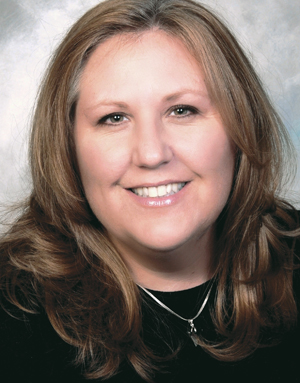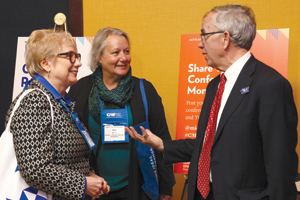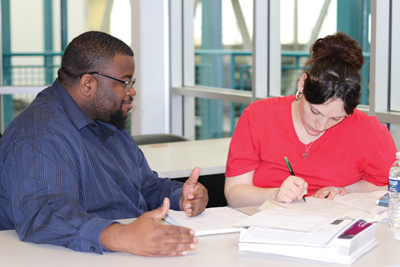
Nonprofit organizations are affected by some of the same powerful forces as the private sector—the economy, government regulations and changing demographics. In Michigan, experts in the nonprofit sector note these particular trends, among others:
• expanded inter-agency collaboration
• a major turnover in nonprofit leadership
• new methods of giving
• challenging tax policies
The recession of 2008 is cited as a central event in the nonprofit world. “Between 2008 and 2015 Michigan lost 11,000 nonprofits. This led to mergers and collaborations. We needed to reinvent ourselves to be a whole lot smarter,” says Robert Collier, executive director, Michigan Council of Foundations.
“In 2008 we lost a lot of corporate foundation money, so federal and state contracts became more important. Funders were looking for innovation. Nonprofits had to provide a fully fleshed out project and budget. For workforce development programs, you need to have a corporate alliance so that there is a job at the end of the training and education,” says Diane Renaud, executive director and CEO of the St. Vincent and Sarah Fisher Center in Detroit.

Donna Murray-Brown, president and CEO of the Michigan Nonprofit Association, concurs that the recession was a catalyst for change—specifically breaking down barriers or “silos” between nonprofit organizations.
Collaboration for bigger impact
“When resources were scarce, there was pressure from the foundation community to collaborate. They thought it would be more efficient. Now it is partly money, but also a desire for greater impact,” she explains. Plus, collaborations are easier than mergers, Murray-Brown says. The Michigan Nonprofit Association has almost 1,000 nonprofit members and serves all nonprofits in the state.

Rick Kress, a nonprofit consultant who specializes in big gifts and governance, has chaired five local nonprofit boards and serves on the Planned Giving Roundtable of the Association of Fundraising Professionals-Detroit Chapter. He acknowledges that cooperation and collaboration between organizations are meaningful to donors, but difficult to accomplish.
According to Jennifer Miller Oertel, a partner and practice group leader of the Tax-Exempt Organization and Impact Investing Group at law firm Jaffe, Raitt, Heuer and Weiss, her clients collaborate when they realize that they’re not the only ones working in a particular area and want to maximize their resources.
“Collaboration is a common criterion now. Foundations ask nonprofits, especially new ones, who else is providing this service? We ask about their collaborations and partnerships,” said Collier of the Michigan Council of Foundations.
Renaud views partnerships as a way to address competition for sponsorships and other funding for nonprofits. “We have to avoid redundant services and fill in each other’s gaps,” she says.
St. Vincent and Sarah Fisher Center provides GED classes and “soft-skills” training (communication, time management and other work-related skills) at other nonprofit organizations, such as Focus: HOPE. This improves access for clients and reduces transportation costs. Also, the space is provided rent-free. After completing an educational component, these individuals become applicants for partners’ programs. The Center also collaborates with other nonprofits on grants, pilot programs to test new approaches, and shared resources.
Nonprofit collaboration can take many different forms—backroom operations, IT, shared social media communication to advocate for an issue, and joint programs, Collier explains. Bridging organizational barriers is a strategy for foundations as well as nonprofits today.
Foundations increasingly work with other organizations
“There is more collective giving. Funders are getting together to solve a particular problem—collaborating around early childhood, education and health,” says Oertel.
“If foundations want to have an impact, they need to collaborate. Michigan has a history of public/private partnerships in Grand Rapids, Kalamazoo, Detroit, the UP, and other areas.” says Collier. “How can we leverage our financial and human resources—both public money and private foundation funds—on behalf of Michigan residents?”
One example of public-private cooperation is Michigan’s Regional Prosperity Initiative. Ten geographic areas were designated by the state in 2014 to encourage “local private, public and nonprofit partners to collaborate to create vibrant regional economies.
Competitive annual grants of $250,000 to $500,000 are offered for local collaborations to advance economic development, workforce training, higher education, and transportation. The goal is to promote strong regional economic strategies based on collaboration among local government, nonprofit and for-profit organizations.
CEO turnover is affecting nonprofits
Besides encouraging collaboration, the recession had another effect on nonprofits—a delay in CEO retirements, according to Renaud and Gary Dembs, CEO and executive director of the Michigan Non-Profit Personnel Network. Out of concern for job and financial security, nonprofit executives were likely to put off potential moves to other jobs or retirement during the recession.
But recently, that has changed. Dembs says that this year there will be 240 leadership transitions among Michigan nonprofit CEOs—75 percent through retirements. He says this is part of a national trend.
According to Collier, the increase in new CEOs and joint CEOs (serving two nonprofits) is contributing to inter-organization collaboration.

“Transitions make or break an organization. A succession plan is part of strategic planning in a way that it hasn’t been in the past. There is a lot more movement since the end of the recession.”
Dembs says that boards are “looking farther ahead and that the biggest thing is growing their own talent—an ‘heir apparent.’” He says that nonprofit boards typically consider at least one internal candidate, several external nonprofit candidates and one or two corporate candidates for a CEO position.
“There is an intentional process to include more diverse candidates in terms of ethnicity, race, gender and experience. Candidates may come from another sector,” says Murray-Brown.
Demographics are also a factor in this leadership transition—many nonprofit CEOs are baby boomers, an age when retirement or semi-retirement is appealing. Demographics are also affecting giving trends in the nonprofit world.
Donors want to have an impact
Baby boomers are the major holders of wealth—80 percent according to Kress. He says that women are responsible for most giving, especially those who have their own companies and money. However, nonprofits must also reach out to millennials, who often have a different approach to philanthropy.
“Millennials and other new donors want to know what impact you are having. They want stories and data to show how are we making a difference,” says Collier.
Kress says that donors want to be kept informed, with the idea that it’s “not just a giveaway. It’s an investment for me. I want to know how it’s working.” He adds that very successful fundraising organizations provide personal reports to donors, lunch with a president or doctor, or private tours.
“Everybody is driven by return on investment. No one wants to see that their money is being thrown away,” says Renaud.
From her perspective, people are giving in different ways, which is often generational. In the past, donors would send an annual check but now, she says, “People would rather spread out their donations unless they have a personal connection.”
One new trend is “impact investing” which merges capitalism and philanthropy for greater social impact, Oertel explains. Instead of grants, funders offer low-interest loans. “You are recharging your giving pot,” she says.
Donors can loan money at 2 percent interest to nonprofits, individuals or small businesses to create sustainable revenue streams, she says. “There are trillions of dollars of need and only bills of capital to give. This can solve that gap,” Oertel claims.
Another trend is donor-advised funds—nonprofit funds created by individuals or families for charitable purposes. Some are maintained by local community foundations while others are set up through brokerage firms such as Schwab and Fidelity.
Donor-advised funds increasing
Collier points to an “enormous” increase in donor-advised funds, partly because they are easy to set up and flexible. Community foundations are required to have policies that require distribution of more than 5 percent of fund assets annually, Oertel says. Also, they are familiar with local social service and other charitable needs, so funds are likely to be allocated in worthwhile ways.
However, brokerage firms, which provide immediate tax benefits for donor-advised funds, have fewer rules about distribution. According to Kress, there is no public record of who has donor-advised funds, which he considers “untapped resources” for nonprofits. He suggests that nonprofit organizations “plant the seed in their newsletters” or connect with financial planners.
Tax policy changes challenge nonprofits
While tax policy has been an important aspect of for-profit business planning and success, taxes have not been a major concern for many nonprofit organizations. However, this is changing at both the state and federal levels. As of 2011, the State of Michigan eliminated the deduction for charitable contributions on state income tax returns. Since then, Murray-Brown says that people continued to give, but at lower levels.
Changes in federal tax regulations are potentially more serious.
“The (federal) Tax Act of 2017 caused some real issues for nonprofits,” says Collier. One provision doubled the standard deduction for taxpayers, which means that some donors won’t be able to itemize and gain a tax benefit from their charitable gifts. Collier predicts that the Tax Reform Act won’t have much impact in 2018 because people don’t understand it, but he anticipates a drop among middle-class donors in 2019.
“For the wealthy, this is not as relevant, but for others, it’s not clear. It may be an issue,” says Murray-Brown.
Kress agrees. “For million dollar givers, taxes are not a big issue. For people on the fence, that could tip it a bit.”
Diane Renaud at St. Vincent and Sarah Fisher Center, based in Detroit, is very concerned about the impact of tax law changes on philanthropy. “It’s terrifying to me. I have no idea which way it’s going to go. It’s a mixed bag—some people give from the heart and will continue.”

There is also uncertainty about the Unrelated Business Income Tax (UBIT)—a new federal tax on fringe benefits, such as parking and travel that some nonprofits provide to their employees. Since nonprofits often don’t offer salaries that are competitive with the private sector, these benefits may be especially important for their employees. There has been no guidance on this from the U.S. Treasury, Collier notes.
“There is national advocacy to delay the tax since nonprofits didn’t know about it in advance,” Renaud says. The Michigan Council of Foundations is part of a national coalition addressing this issue, Collier says, and multiple bills have been introduced in Congress to delay implementation or repeal the UBIT.
The uncertain impact of these federal tax policies is bound to be an important challenge for nonprofit leaders—both CEOs and voluntary directors. Unlike for-profit businesses, nonprofits can’t simply raise their prices.







